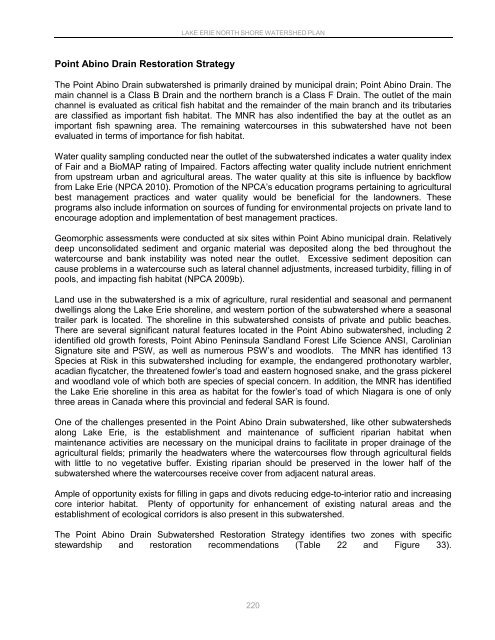Lake Erie North Shore Watershed Plan - Niagara Peninsula ...
Lake Erie North Shore Watershed Plan - Niagara Peninsula ...
Lake Erie North Shore Watershed Plan - Niagara Peninsula ...
You also want an ePaper? Increase the reach of your titles
YUMPU automatically turns print PDFs into web optimized ePapers that Google loves.
LAKE ERIE NORTH SHORE WATERSHED PLAN<br />
Point Abino Drain Restoration Strategy<br />
The Point Abino Drain subwatershed is primarily drained by municipal drain; Point Abino Drain. The<br />
main channel is a Class B Drain and the northern branch is a Class F Drain. The outlet of the main<br />
channel is evaluated as critical fish habitat and the remainder of the main branch and its tributaries<br />
are classified as important fish habitat. The MNR has also indentified the bay at the outlet as an<br />
important fish spawning area. The remaining watercourses in this subwatershed have not been<br />
evaluated in terms of importance for fish habitat.<br />
Water quality sampling conducted near the outlet of the subwatershed indicates a water quality index<br />
of Fair and a BioMAP rating of Impaired. Factors affecting water quality include nutrient enrichment<br />
from upstream urban and agricultural areas. The water quality at this site is influence by backflow<br />
from <strong>Lake</strong> <strong>Erie</strong> (NPCA 2010). Promotion of the NPCA‟s education programs pertaining to agricultural<br />
best management practices and water quality would be beneficial for the landowners. These<br />
programs also include information on sources of funding for environmental projects on private land to<br />
encourage adoption and implementation of best management practices.<br />
Geomorphic assessments were conducted at six sites within Point Abino municipal drain. Relatively<br />
deep unconsolidated sediment and organic material was deposited along the bed throughout the<br />
watercourse and bank instability was noted near the outlet. Excessive sediment deposition can<br />
cause problems in a watercourse such as lateral channel adjustments, increased turbidity, filling in of<br />
pools, and impacting fish habitat (NPCA 2009b).<br />
Land use in the subwatershed is a mix of agriculture, rural residential and seasonal and permanent<br />
dwellings along the <strong>Lake</strong> <strong>Erie</strong> shoreline, and western portion of the subwatershed where a seasonal<br />
trailer park is located. The shoreline in this subwatershed consists of private and public beaches.<br />
There are several significant natural features located in the Point Abino subwatershed, including 2<br />
identified old growth forests, Point Abino <strong>Peninsula</strong> Sandland Forest Life Science ANSI, Carolinian<br />
Signature site and PSW, as well as numerous PSW‟s and woodlots. The MNR has identified 13<br />
Species at Risk in this subwatershed including for example, the endangered prothonotary warbler,<br />
acadian flycatcher, the threatened fowler‟s toad and eastern hognosed snake, and the grass pickerel<br />
and woodland vole of which both are species of special concern. In addition, the MNR has identified<br />
the <strong>Lake</strong> <strong>Erie</strong> shoreline in this area as habitat for the fowler‟s toad of which <strong>Niagara</strong> is one of only<br />
three areas in Canada where this provincial and federal SAR is found.<br />
One of the challenges presented in the Point Abino Drain subwatershed, like other subwatersheds<br />
along <strong>Lake</strong> <strong>Erie</strong>, is the establishment and maintenance of sufficient riparian habitat when<br />
maintenance activities are necessary on the municipal drains to facilitate in proper drainage of the<br />
agricultural fields; primarily the headwaters where the watercourses flow through agricultural fields<br />
with little to no vegetative buffer. Existing riparian should be preserved in the lower half of the<br />
subwatershed where the watercourses receive cover from adjacent natural areas.<br />
Ample of opportunity exists for filling in gaps and divots reducing edge-to-interior ratio and increasing<br />
core interior habitat. Plenty of opportunity for enhancement of existing natural areas and the<br />
establishment of ecological corridors is also present in this subwatershed.<br />
The Point Abino Drain Subwatershed Restoration Strategy identifies two zones with specific<br />
stewardship and restoration recommendations (Table 22 and Figure 33).<br />
220
















